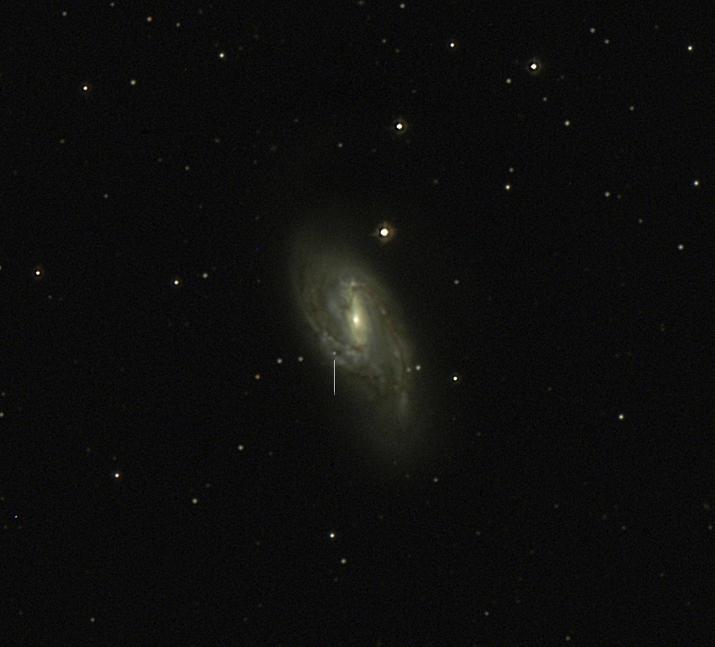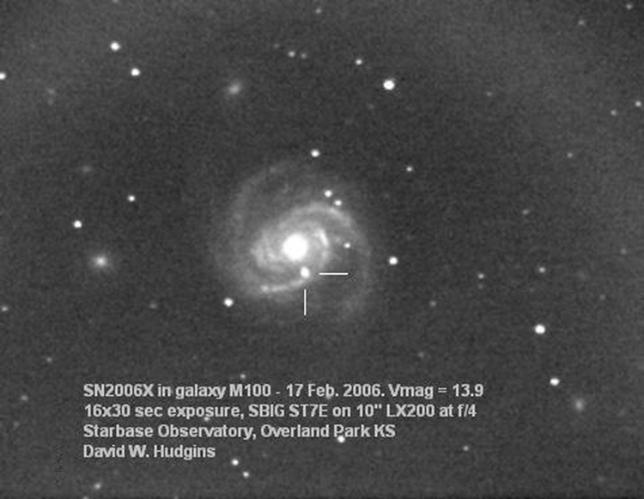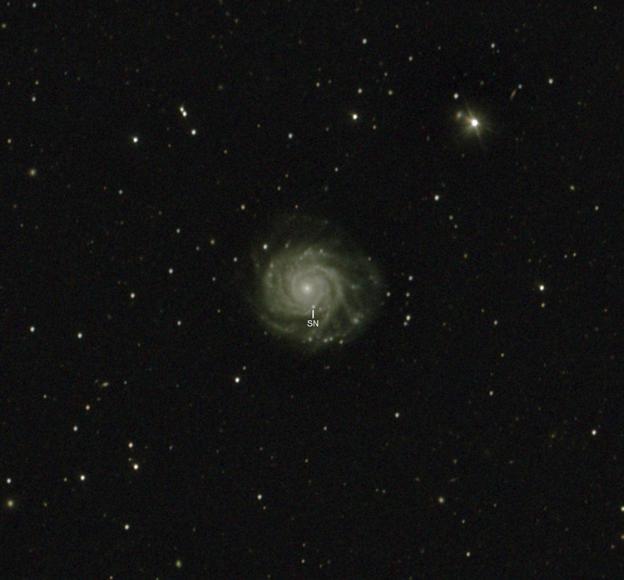| SUPERNOVAE Images on this page show supernovae in neighboring galaxies All images were taken through the C-11 with the StarlightExpress SXVR-H694C camera |

SUPERNOVA IN GALAXY NGC-6946: Once again NGC-6946 is in the spotlight! This galaxy has had 10 super
novae in the last 100 years, the last one occurring in 2004. This image shows supernova 2017eaw, a type IIP
supernova which was discovered by Patrick Wiggins on May 14th, 2017. This image captured on the morning of
May 29th, at which time the supernova was shining at 12.8 magnitude. This is one hour of data (10 X 6 minute
subs) through the C-11 at f/2 using HyperStar and the SXVR-H694C one-shot color imager.
novae in the last 100 years, the last one occurring in 2004. This image shows supernova 2017eaw, a type IIP
supernova which was discovered by Patrick Wiggins on May 14th, 2017. This image captured on the morning of
May 29th, at which time the supernova was shining at 12.8 magnitude. This is one hour of data (10 X 6 minute
subs) through the C-11 at f/2 using HyperStar and the SXVR-H694C one-shot color imager.

SUPERNOVA 2016cok IN GALAXY M-66: Discovered May 28, 2016 by the All Sky Automated Search for
Supernovae (ASA-SN) of Ohio State University, located on Mt Heleakala, Hawai'i. This a type II supernova,
caused by the collapse of a massive star over 10 times larger than our sun. The collapse and subsequent shock
wave caused this titanic explosion in M-66, a spiral galaxy lying more than 35 million light years from earth. This
image was captured on June 4th, 2016. This is 35 minutes of data through the C-11 at f/2, using HyperStar and
the SXVR-H694C one-shot color imager.
Supernovae (ASA-SN) of Ohio State University, located on Mt Heleakala, Hawai'i. This a type II supernova,
caused by the collapse of a massive star over 10 times larger than our sun. The collapse and subsequent shock
wave caused this titanic explosion in M-66, a spiral galaxy lying more than 35 million light years from earth. This
image was captured on June 4th, 2016. This is 35 minutes of data through the C-11 at f/2, using HyperStar and
the SXVR-H694C one-shot color imager.

SUPERNOVA 2014j IN GALAXY M-82: Discovered on January 21, 2014 by Steve Fossey at the University of
London. This is a type I-a supernova, caused by the explosion of a massive white dwarf star. The supernova
was 12th magnitude when discovered, and brightened to 10.5, making it a striking sight. This image was
captured on April 4, 2014, and is 1 hour of data through the C-11 at f/2 using HyperStar and the SXVR-H694C
one-shot color imager. By this date, the supernova had faded to 13.4 magnitude.
London. This is a type I-a supernova, caused by the explosion of a massive white dwarf star. The supernova
was 12th magnitude when discovered, and brightened to 10.5, making it a striking sight. This image was
captured on April 4, 2014, and is 1 hour of data through the C-11 at f/2 using HyperStar and the SXVR-H694C
one-shot color imager. By this date, the supernova had faded to 13.4 magnitude.

SUPERNOVA 2013ej IN SPIRAL GALAXY M-74: This supernova was discovered on July 25, 2013 by the Lick
Observatory Supernova Search (LOSS). At the time of its discovery it shone at 13th magnitude. This is a type II
supernova and was discovered very early in its eruption. This image was captured on August 13, 2013 and is 30
minutes of data through the C-11 at f/2 using the SXVR-H694C one-shot color imager. By this time, the supernova
had brightened to 12.5 magnitude.
Observatory Supernova Search (LOSS). At the time of its discovery it shone at 13th magnitude. This is a type II
supernova and was discovered very early in its eruption. This image was captured on August 13, 2013 and is 30
minutes of data through the C-11 at f/2 using the SXVR-H694C one-shot color imager. By this time, the supernova
had brightened to 12.5 magnitude.

SUPERNOVA 2013dy IN GALAXY NGC-7250: This supernova was discovered on July 10th, 2013 by the Lick
Observatory Supernova Search (LOSS). At the time of discovery it shone at 16.7 magnitude, but had brightened to
13th magnitude by the time this image was captured on the evening of August 10, 2013. This is 1 hour of data shot
through the C-11 at f/2 using HyperStar and the SXVR-H694C one-shot color imager.
Observatory Supernova Search (LOSS). At the time of discovery it shone at 16.7 magnitude, but had brightened to
13th magnitude by the time this image was captured on the evening of August 10, 2013. This is 1 hour of data shot
through the C-11 at f/2 using HyperStar and the SXVR-H694C one-shot color imager.

SUPERNOVA 2011dh IN SPIRAL GALAXY M-51: This supernova was discovered on May 31st 2011 by
astronomers Tom Reiland (USA), Thomas Griga (Germany), and Stephane Bailey (FRANCE). It is a type
IIb supernova. At the time of its discovery, it was 14th magnitude. This image was captured on June 9th,
2013, when the supernova had brightened to 12.6 magnitude. This is 30 minutes worth of data through
the C-11 at f/2 using the Orion StarShoot CCD imager.
astronomers Tom Reiland (USA), Thomas Griga (Germany), and Stephane Bailey (FRANCE). It is a type
IIb supernova. At the time of its discovery, it was 14th magnitude. This image was captured on June 9th,
2013, when the supernova had brightened to 12.6 magnitude. This is 30 minutes worth of data through
the C-11 at f/2 using the Orion StarShoot CCD imager.

SUPERNOVA 2006x IN SPIRAL GALAXY M-100: This supernova was discovered on February 7th,
2006 by Shoji Suzuki (JAPAN), and M. Migliardi (ITALY). At the time of its discovery it was only 16.5
magnitude, but by the time this image was taken, on February 22nd, it had brightened to 14th
magnitude and was easily seen visually through my 11-inch Celestron. This image was taken by my
friend David Hudgins at his Starbase Observatory in Overland Park. It is 8 minutes of data through a
10-inch SCT, using an Santa Barbara Instruments ST7E monochrome CCD imager.
2006 by Shoji Suzuki (JAPAN), and M. Migliardi (ITALY). At the time of its discovery it was only 16.5
magnitude, but by the time this image was taken, on February 22nd, it had brightened to 14th
magnitude and was easily seen visually through my 11-inch Celestron. This image was taken by my
friend David Hudgins at his Starbase Observatory in Overland Park. It is 8 minutes of data through a
10-inch SCT, using an Santa Barbara Instruments ST7E monochrome CCD imager.

SUPERNOVA 2017 in NGC-3938: This supernova was discovered on May 25th, 2017 in spiral galaxy
NGC-3938, a face-on spiral galaxy in Ursa Major, located about 5 degrees south of Chi Ursae Majoris.
This image was captured on the evening of June 19th, 2017 when the supernova was shining at about
15th magnitude. This image is an integration of eight 360-second exposures for a total of 48 minutes of
data. Guided, captured and combined using Maxim DL 5 Pro. Post processed in Photoshop CS2, Levels,
curves, Gradient XTerminator, StarShrink, and Astro Tools.
NGC-3938, a face-on spiral galaxy in Ursa Major, located about 5 degrees south of Chi Ursae Majoris.
This image was captured on the evening of June 19th, 2017 when the supernova was shining at about
15th magnitude. This image is an integration of eight 360-second exposures for a total of 48 minutes of
data. Guided, captured and combined using Maxim DL 5 Pro. Post processed in Photoshop CS2, Levels,
curves, Gradient XTerminator, StarShrink, and Astro Tools.